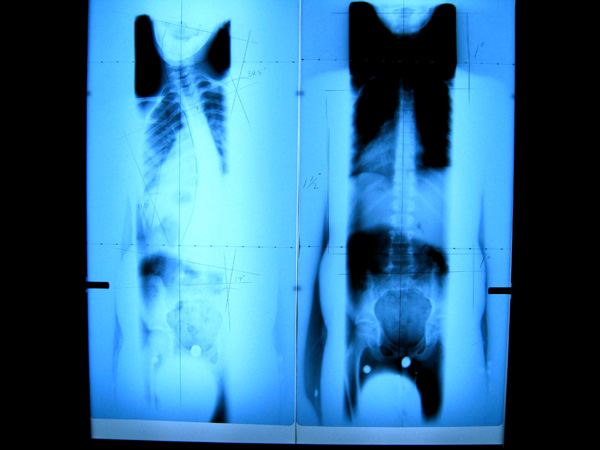Hi, I’m Dr. Steve Battaglino with Battaglino Family Chiropractic.
“Is it okay to get my child checked by a chiropractor?” is a question I get asked quite a lot. “Why should I get my kids checked? They haven’t had a bunch of traumas, they haven’t worked at an office for 30 years.” These are good questions and I want to show you some x-rays of the neck to show you why we would want to get kids checked.
This is a side view of the neck, so this would be where the jaw comes out, the patient’s looking this way, this is the base of the skull. The spine, in the neck, it’s supposed to have a curvature like this. You can see this curvature isn’t quite there, it kind of just leans forward. The other thing that we look for is spaces in between the bones. This is where the disk lives, we can see these spaces at these levels, except for here. At this level, we can see that the disk is worn out and that the bones have actually fused together.
This patient is 51 years old and she had no idea how this could have happened until we started to talk and she realized that at eight years old, she fell off a swing set, onto her head, in this position, was knocked unconscious for five minutes, and then she woke up and she seemed to be okay other than a headache. Her parents never took her to the doctor. We see that, down the road, decades later, this has worn out and this is the site of that injury. The injury did not look like this when she was eight years old. If we would have been able to adjust the patient when she was… After that accident, it would have changed the structure of that area and it wouldn’t have grown that way. This is the result of decades of wear and tear from that area not moving. It was misaligned in the accident and never kind of got moving again properly.
Look at this x-ray and this is an x-ray of a 28-year-old female. You can see that the curve starts here but instead of continuing like this, it buckles right here and then it reverses. This, again, the patient was a gymnast and when she was involved in gymnastics at nine years old, she took a fall on her head, didn’t seem like a big deal, but then we looked and instead of having a positive curvature, again, it’s supposed to be like a spring or a coil that the weight of the head sits on top of, she’s got a negative curvature. It puts a lot of stress on the bones and joints of the neck, particularly here, and then down lower, and we’re starting to see some bone spurring. You can see the distance here compared with the distance here, it looks like the bones are almost touching here, here, and getting close here. This wear and tear is because of the structural alignment of the neck. Again, if we would have checked the patient when she was nine years old after this happened, it would have restored proper alignment and she would have grown properly. It’s like if you’re backing out of the driveway and you hit a sapling tree with your car and it puts a bend in it, well, as that tree grows it’s gonna grow with that bend in there and it’s going to be crooked, so that’s what’s happening here.
Predisposes the joints and discs for premature arthritis because they wear out a lot more quickly if they’re not aligned properly, but the other thing that we don’t see on x-ray are the nerves that come out of the neck and elsewhere in the spine that go to run our body. So it’s restricted nerve flow when we have compression in these areas. It’d be much better if we could treat her when she was a child and it would be just maybe a handful of visits to get this area properly fixed and avoid all this lifetime of problems.
This is a normal curvature, just to give you an idea. You can see the alignment here, it looks real nice. This is not a normal curve, again, this is a reversed curve, the jaw is here. This patient was 42 years old. She came in, she didn’t actually have any neck pain at all, which is another important point. We have a lot of nerves that come out of the spine at each level, some of those nerves are pain nerves, but only about 10%, the other 90% are going to run the body. What she did have was numbness and tingling and weakness in her hands, so much so that she had had a carpal tunnel surgery on both sides and it didn’t really help. She works typing at a legal office, really busy office, and she was… Her hands were going numb and falling asleep and so she was having a hard time working. We were able to establish a positive curvature in the neck after a course of care, but only a positive like one or two degrees. The reason it wasn’t able to go to an ideal curve, which is maybe 40 degrees, is because it was limited by this area. This area is very nearly fused together, but it was enough of an improvement so that her symptoms went away, and she was able to work and be perfectly happy and pain-free, but if we could have caught this earlier, it would have been much more of a fixable scenario instead of just a patchable partial fix.
This is Dr. Steve Battaglino with your health minute, and I’m encouraging to get your child checked by a qualified chiropractor. It’ll make a huge difference in their health today and in the future.

